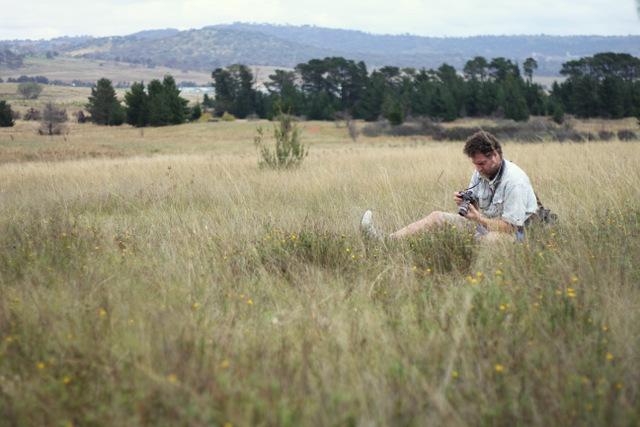
This scenic site conserves populations of several threatened species. Wildflower displays are expected in spring and summer, particulalry patches of Button Wrinklewort, Hoary Sunray and Blue Devil. The patch of woodland in the north is the habitat for a variety of woodland birds, while the grassland section has several species of threatened fauna. A large mob of Eastern Grey Kangaroos makes the reserve its home.
Hoover Drive, Queanbeyan, NSW
No facilities. A dirt track allows access throughout the reserve.
Area Manager, NSW NPWS, 11 Farrer Place, Queanbeyan, NSW, 2620
Phone: 03 6229 7166; Email: info@environment.nsw.gov.au
Contact hours: 9am-12.30pm Monday to Friday.
Website: http://www.nationalparks.nsw.gov.au/visit-a-park/parks/queanbeyan-nature...
A small section of Queanbeyan NR was gazetted in 1989 to conserve a population of Button Wrinklewort. A larger section was added in 2003, to conserve natural grassland, box-gum woodland, and populations of Button Wrinklewort and several threatened species of grassland fauna. Prior to its gazettal, the small section was a Crown reserve, managed by Queanbeyan City Council. The larger section was formerly NSW State Government land setaside for future housing development. Many years priorto this identified need, the land was a small farm used for cattle grazing. The site of anold farm-house is still visible in the southern section of the reserve, marked by a grove of exotic trees.
A very diverse site with the nationally listed endangered ecological community, Natural Temperate Grassland of the South Eastern Highlands as well as a patch of White Box - Yellow Box - Blakely's Red Gum Woodland (Box-Gum Woodland). The site conserves the only population of Endangered (Commonwealth) Button Wrinklewort in the NSW Reserve System. Other threatened entities include Golden Sun Moth (Commonwealth Critically Endangered), Grassland Earless Dragon (Commonwealth Endangered), Hoary Sunray (Commonwealth Endangered) and many other significant and regionally declining flora species.
Natural Temperate Grassland of the South Eastern Highland, White Box - Yellow Box - Blakely's Red Gum Grassy Woodland
Spring and summer wildflowers, scenic values and fauna including grassland and woodland mammals and birds. There are woodland patches, which provide habitat for a range of woodland bird species.
Ongoing management activities include: weed control (woody species and significant grassland weeds such as Africa Lovegrass, Chilean Needlegrass, Serrated Tussock and St John's Wort); weed control monitoring using detailed plot monitoring; ongoing reptile and Golden Sun Moth monitoring.
Dog walking and vehicle access are not permitted in the reserve. Please do not handle the monitoring equipment.
At least 123 native species, including: Acacia dealbata, Acacia genistifolia, Acacia mearnsii, Acacia pycnantha, Acaena ovina, Amyema sp., Aristida behriana, Aristida ramosa, Asperula conferta, Astroloma humifusum, Austrostipa bigeniculata, Austrostipa densiflora, Austrostipa scabra, Bossiaea buxifolia, Bothriochloa macra, Brachyloma daphnoides, Bulbine bulbosa, Bursaria spinosa, Calocephalus citreus, Carex appressa, Carex breviculmis, Carex chlorantha, Carex inversa, Cassinia quinquefaria, Euphorbia drummondii, Chloris truncata, Chrysocephalum apiculatum, Chrysocephalum semipapposum, Convolvulus angustissimus, Crassula sieberiana, Cheilanthes sp., Cryptandra amara, Cymbonotus lawsonianus, Cynodon dactylon, Cynoglossum suaveolens, Daucus glochidiatus, Daviesia mimosoides, Desmodium varians, Dianella longifolia, Dianella revoluta, Dichelachne sp., Dichondra repens, Anthropodium fimbriatum, Drosera peltata, Einadia nutans, Eleocharis acuta, Elymus scaber, Enneapogon nigricans, sSmooth Willow-erb, Eragrostis brownii, Eragrostis parviflora, Erodium crinitum, Eryngium ovinum, Eucalyptus blakelyi, Eucalyptus bridgesiana, Eucalyptus macrorhyncha, Eucalyptus melliodora, Euchiton involucratus, Euchiton japonicus, Glycine clandestina, Glycine tabacina, Gonocarpus tetragynus, Goodenia hederacea, Goodenia pinnatifida, Haloragis heterophylla, Hydrocotyle laxiflora, Hypericum gramineum, Isoetopsis graminifolia, Isotoma fluviatilis, Juncus filicaulis, Juncus sp., Kunzea ericoides, Leptorhynchos squamatus, Leucochrysum albicans, Leucopogon fletcheri, Lissanthe strigosa, Lomandra bracteata, Lomandra filiformis, Lomandra longifolia, Lomandra multiflora, Melichrus urceolatus, Mentha diemenica, Microlaena stipoides, Microseris lanceolata, Microtis unifolia, Oxalis perennans, Panicum effusum, Paspalum distichum, Persicaria prostrata, Pimelea curviflora, Pimelea glauca, Plantago varia, Poa labillardierei, Poa sieberiana, Pomaderris sp., Pseudognaphalium luteoalbum, Pterostylis sp., Pultenaea procumbens, Rumex brownii, Rumex dumosus, Rutidosis leptorrhynchoides, Rytidosperma auriculatum, Rytidosperma caespitosum, Rytidosperma carphoides, Rytidosperma laeve, Schoenus apogon, Scleranthus diander, Sebaea ovata, Senecio quadridentatus, Solenogyne dominii, Thelymitra pauciflora, Themeda triandra, Tricoryne elatior, Triptilodiscus pygmaeus, Vittadinia cuneata, Vittadinia muelleri, Vittadinia sp., Wahlenbergia communis, Wahlenbergia luteola, Wahlenbergia stricta, Wurmbea dioica and Xerochrysum viscosum.
An incomplete list of native species recorded includes: Australian Magpie, Australian Pipit, Australian Raven, Australian Wood Duck, Bibron’s Toadlet, Black-faced Cuckoo-shrike, Brown Falcon, Brown Thornbill, Crested Pigeon, Crimson Rosella, Common Eastern Froglet, Eastern Grey Kangaroos, Eastern Rosella, Flame Robin, Galah, Gang-gang Cockatoo, Golden Sun Moth, Grassland Earless Dragon, Grey Butcherbird, Grey Currawong, Grey Fantail, Grey Shrike-Thrush, Little Corella, Little Eagle, Magpie-lark, Nankeen Kestrel, Noisy Friarbird, Pied Currawong, Red Wattlebird, Red-rumped Parrot, Rufous Songlark, Rufous Whistler, Scarlet Robin, Spotted Grass Frog, Spotted Pardalote, Striated Pardalote, Stubble Quail, Sulphur-crested Cockatoo, Superb Fairy-wren, Wedge-tailed Eagle, Welcome Swallow, White-browed Woodswallow, White-faced Heron, White-plumed Honeyeater, White-winged Triller, Willie Wagtail, Yellow-faced Honeyeater, Yellow-rumped Thornbill and Yellow-tailed Black-Cockatoo.